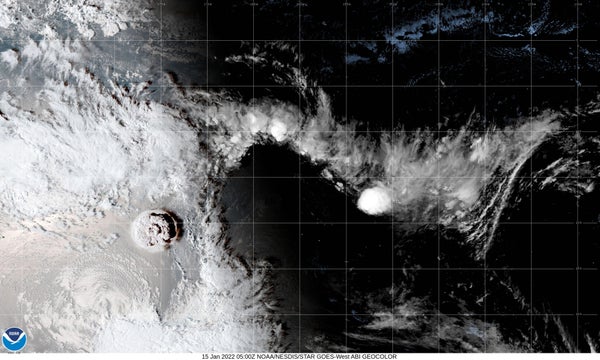The Hunga Tonga–Hunga Ha‘apai volcano in the area of the Tonga Islands in the South Pacific Ocean blew its top in a massive eruption in January 2022. In addition to an enormous plume of gas and debris, the eruption triggered pressure waves that rippled through the entire planet’s atmosphere, set off a sonic boom heard as far away as Alaska and unleashed a tsunami that swept over nearby islands.
The dramatic event was particularly intriguing to scientists focused on elusive atmospheric phenomena; a host of satellites monitored the effects of the eruption. Since then researchers have published a large number of papers on the atmosphere’s response to the eruption, says David Themens, a space weather scientist at the University of Birmingham in England who has published on the topic.
In one piece of new research, Japanese scientists used data from two satellites to understand the giant, and wonky, equatorial plasma bubble that formed after the eruption. Plasma bubbles are regions with a much lower density of the charged particles called plasma than are generally found in the upper atmosphere. These bubbles usually form when various types of waves in the atmosphere destabilize the lower edge of the ionosphere—a layer of Earth’s atmosphere that stretches from dozens to hundreds of kilometers above the planet’s surface and is dominated by charged particles. Researchers think the Tonga eruption created pressure waves, which cause the pressure of a material—in this case, air—to rise and fall. That action triggered a bubble to form near the equator.
On supporting science journalism
If you're enjoying this article, consider supporting our award-winning journalism by subscribing. By purchasing a subscription you are helping to ensure the future of impactful stories about the discoveries and ideas shaping our world today.
The new study found that the bubble stretched some 2,000 kilometers high and covered an area of 670,000 square kilometers (about 30 New Jerseys), according to lead author Atsuki Shinbori, an assistant professor of space and planetary sciences at Nagoya University in Japan.
The researchers also observed that even before atmospheric pressure waves from the eruption arrived, the ionosphere began changing, with negatively charged electrons becoming more prevalent. “The results are exciting and well explain the upward motion of the ionosphere [that] occurred a few minutes to hours before the arrival of air pressure waves in the troposphere,” which is at Earth’s surface, says Guozhu Li, who studies plasma density in Earth’s atmosphere at the Chinese Academy of Sciences and wasn’t involved in the new research.
The researchers say the finding underscores that scientists have more to learn about plasma bubbles—smaller versions of which form daily at sundown—and how the different layers of the atmosphere interact.
Although plasma bubbles sound esoteric, they can interfere with GPS systems because irregularities in the ionosphere change how fast signals from these satellites reach devices on the ground. An average person using GPS to navigate a city may not notice a difference, says Themens, who wasn’t involved in the new study, but the interruptions can be an issue for some ultraprecise uses of GPS, such as in agriculture or mining operations. “Therefore, we need to understand the generation process of the plasma bubbles and predict the plasma bubble occurrence as one of the most important issues in space weather research,” Shinbori says.
The new study suggests industries and people who rely on ionospheric systems could have forewarning of these bubbles. “The ionosphere observations show disturbances occurring ahead of the volcanic atmospheric waves,” says Charles Lin, an atmospheric scientist at National Cheng Kung University in Taiwan, who was not involved in the research. “It is, therefore, possible to develop the early warning system by observing [the] ionosphere.” Such a system could warn people when GPS, for example, might be less reliable.
When it comes to studies of the Tonga eruption itself, Themens says it’s time for scientists to switch gears from observational studies such as this one to computer-modeling work that can help tease apart how different phenomena interact. “I think the breadth of work that’s already been done is quite significant,” he says, adding that the eruption “jump-started” research on these topics.
“In ionospheric science, we don’t get lab experiments because we’re sitting in an environment that we have no control over. So [an extreme, well-studied event like this] is kind of the closest thing to a lab experiment that we have,” Themens says. “We can explore physics that we otherwise would never have been able to.”
